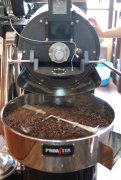Study on roasting Technology of Coffee; freshly roasted coffee beans distinguish the freshness of coffee beans
Technical Research
Editing
A series of chemical changes occur during the baking process. After about 5-25 minutes of baking (depending on the temperature selected), the green coffee beans lose some humidity and turn yellow. In this process, the coffee beans will swell, changing from a strong, high-density raw bean to a low-density fluffy state. After this process, the coffee beans will about double in size and begin to show a light brown after stir-frying. After this stage is completed (after about 8 minutes of baking), the calories will be reduced. The color of the coffee soon changed to dark. When the preset baking depth is reached, cold air can be used to cool the coffee beans in order to stop the baking process.
Baking is roughly divided into shallow baking (Light), medium baking (Medium), urban baking (City) and deep baking (Deep). Light roasted coffee beans: will have a strong smell, very crisp, high acidity is the main flavor and slightly mellow. Medium-roasted coffee beans: have a strong mellow, but also retain a certain degree of acidity. City-baked coffee beans: the surface is dark brown, the acidity is replaced by slight bitterness, and most of the flavor has been destroyed. Deep-roasted coffee beans: dark brown in color and oily on the surface. For most coffee beans, the alcohol content increases significantly and the acidity decreases. In fact, roasting coffee is a way of processing food. The roasting of professional coffee is the personal expression of the roaster. Just started to contact with professional coffee.

Coffee beans with different roasting degrees
(SPCIAITYCOFFEE) the biggest problem is the name of the degree of baking. For example, CITY, FULLCITY, FRENCH, ESPRESSO, etc., all produce different baking colors because of the different baking machines and producing areas. In addition, some roasting levels are named after mixed coffee: for example, ESPRESSO is a coffee with a specific roasting degree for making ESPRESSO, and even if the color looks the same, it may have a completely different flavor. Therefore, the selection of the type of beans, baking temperature and baking method, and the length of baking time are the main factors that determine the final flavor.
Important Notice :
前街咖啡 FrontStreet Coffee has moved to new addredd:
FrontStreet Coffee Address: 315,Donghua East Road,GuangZhou
Tel:020 38364473
- Prev

Coffee and roaster shallow roasting medium and deep roasting
Coffee roasted raw coffee beans themselves do not have any coffee aroma, only after stir-fried, can smell a strong aroma of coffee. So the roasting of coffee beans is the transformation process of the internal components of coffee beans, only after roasting to produce ingredients that can release the aroma of coffee, we can smell the aroma of coffee. Chinese name Coffee Roast Foreign name
- Next

Coffee Maker-Hand Brewing Pot Kalita, Hario Home Make Your Own Coffee Simple Hand Brewing
After all, this thing has some handicraft properties. When talking about cost performance, it is often quite nonsense. Only people who like it don't like it and don't like it conveniently. For example, some plating limited models of Takahiro, although handsome in appearance, sell for two cups of ordinary models or even close to 2000. I am not very willing to buy them (I think it is better to upgrade a bean grinder if I have this money). Even if it is an oil pot, it is used.
Related
- Beginners will see the "Coffee pull flower" guide!
- What is the difference between ice blog purified milk and ordinary milk coffee?
- Why is the Philippines the largest producer of crops in Liberia?
- For coffee extraction, should the fine powder be retained?
- How does extracted espresso fill pressed powder? How much strength does it take to press the powder?
- How to make jasmine cold extract coffee? Is the jasmine + latte good?
- Will this little toy really make the coffee taste better? How does Lily Drip affect coffee extraction?
- Will the action of slapping the filter cup also affect coffee extraction?
- What's the difference between powder-to-water ratio and powder-to-liquid ratio?
- What is the Ethiopian local species? What does it have to do with Heirloom native species?

